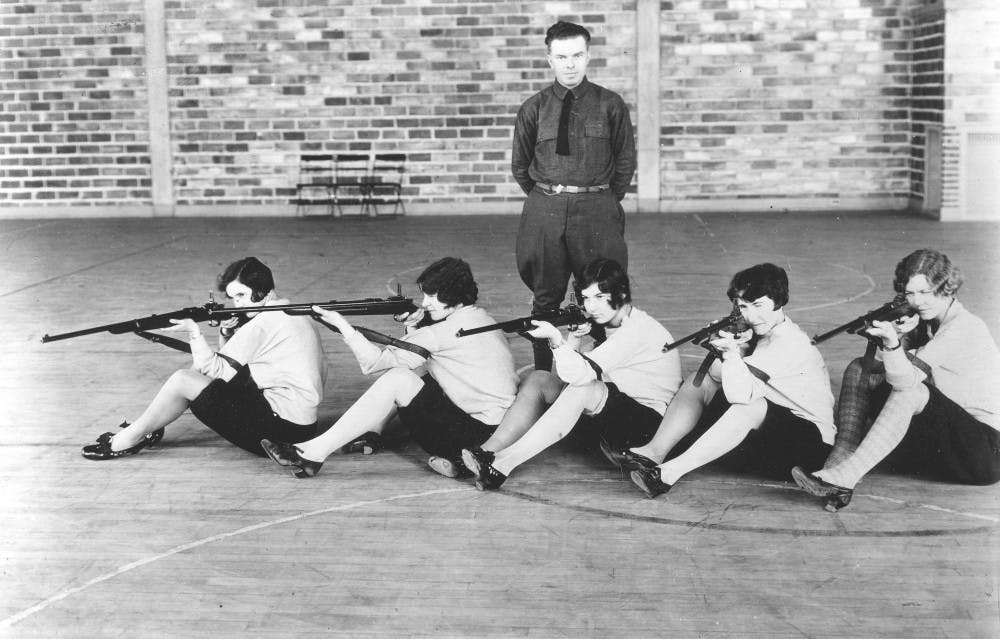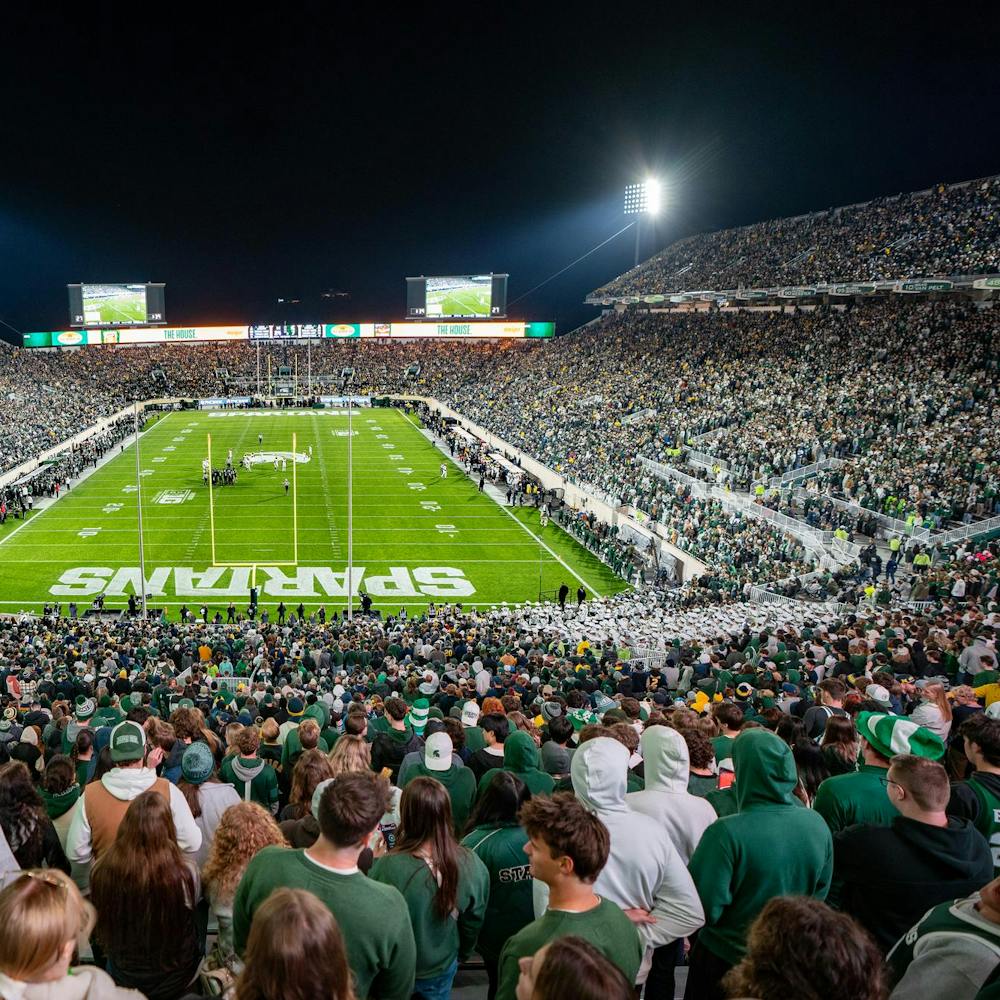A lot has changed since 1847. Since that pivotal year for mid-Michigan, a town of eight registered voters has burgeoned into the state’s fifth-largest city, a model research institution was founded, and the city of East Lansing developed to accommodate the growth.
A moved capital
Following contentious deliberation in Detroit, the state legislature decided in 1847 that a new state capital was needed and selected Lansing as a temporary home base, according to the Greater Lansing Historical Center.
A wooden capitol building was built, with the location intended to be only temporary, but businesses and families nonetheless rushed in, sniffing opportunities for prosperity.
As the capital of Michigan, a distinguishment that Lansing would obviously keep, Lansing recruited numerous other amenities into the community, most importantly the Agricultural College of the State of Michigan.
Signed into effect in 1855, the new higher-education university would not open its doors until 1857.
One stipulation within the bill specifying the college’s creation was that the school had to be within 10 miles of the capitol.
With an agricultural college project that was risky and revolutionary, the state officials wanted to keep in close proximity to oversee its effectiveness.
The beginning of the test was not always promising, as the college scarcely survived six attempts to cut the program in a ten-year span. Meanwhile in Lansing, the new state capital seemed equally inauspicious, as some state representatives slept within the capitol instead of in local lodging, according to Valerie Marvin of the Historical Society of Greater Lansing.
Alongside the Agricultural College of the State of Michigan was the Michigan Female College, also begun in 1855. Despite a tumultuous beginning, the surrounding areas of Lansing developed, the two colleges steadily grew and helped to create new neighborhoods.
MSU has changed its name five times throughout its history, and the first alteration came in 1861 when it was renamed the “State Agricultural College.”
It kept the title for the rest of the 19th century. Other lasting changes came throughout the century, as in 1862 the Morrill Act appropriated funds to imitate the land-grant operation in other states, with the State Agricultural College serving as the model. In 1870, the first female students were enrolled in the State Agricultural College, and in 1873, “The Rock” and the Beal Botanical Gardens were donated and planted, respectively.
At the turn of the century, the State Agricultural College consisted of 627 students of different academic standings, and the outside area continued to expand. The college’s growth continued to broaden the reach of Lansing further and further until it was curtailed 1907, when a decision was made to separate “Collegeville” from the capital.
The city begins
Collegeville and the dependent housing nearby were chartered as the completely independent city of East Lansing, although a local community had existed for some time before.
In 1909, Michigan Agricultural College, MAC, was announced as the school’s new name, according to the MSU website.

MAC was then renamed the Michigan State College of Agriculture and Applied Science, or MCC, in 1925 to accurately symbolize the school’s diverse course offerings. In that same year, the student union was finally completed after ten years of meticulous planning before World War I and entirely renewed efforts from scratch afterwards.
Following the demolition of College Hall, Beaumont Tower was dedicated on June 22, 1929 as a tribute to College Hall, the university’s first building that had simply become decrepit with a lack of maintenance.
The basketball program took flight, literally, in 1931 for the first time in the nation’s history. The away trip to Marquette is believed to be the first time that a college basketball team flew to a game. Spearheading technological advancements five years later, Lyman Briggs was invited to the White House to present and research the harnessing of atomic power.
In 1939, MCC won its first NCAA championship as the cross country team strode to the school’s first title in any major sport. Corresponding with the sports success, the Jenison Gymnasium and Fieldhouse was opened along with the auditorium.
John Hannah, the university’s most famed president, assumed his role in 1941, immediately demanding sweeping changes. New residential and academic halls were constructed, and the Spartan or Sparty Statue was dedicated in 1945, after professor Leonard Jungwirth was charged with sculpting a memorable statue. With Ohioan red clay and Grand Ledge firing, the statue emerged as the world’s largest free-standing ceramic figure.
MSU named
The fifties were frenetic times for the Spartans stretching across all categories. The football team were the national champions in 1951, 1952, 1955 and 1957, while Spartan Willie Thrower became the first African-American quarterback in the NFL. From 1954 to 1957, the school grew from 14,000 students to 20,000 and declared itself a university in 1955. Just one year after the main library was built in 1954, the Honors College was organized.
In the next decade, Case Hall became the university’s first co-ed dorm in 1962, and by 1969, the bustling campus was home to 40,000 students. In 1964, Michigan State University was decided upon as the final name for the academy. Jan. 27, 1967 was the first snow day to pardon classes.
Athletic success was an emblem of the decade, too, as Hugh “Duffy” Daughtery led the team to back-to-back football championships in 1965 and 1966. In 1966, the hockey team doubled up on the school’s success, winning its first national title.
In 1970, Clifton Wharton was named president of MSU, qualifying him as the first African-American president at any major university. In 1972, the MSU band admitted its first two women members.
And in 1979, Earvin “Magic” Johnson led the Spartans to their first basketball championship.
In 1982, James Blanchard, an MSU graduate, was voted into the governor’s office of Michigan. The Wharton Center for the Performing Arts debuted that same year. In 1986, the late legendary hockey coach Ron Mason spurred on the Spartans to the men’s ice hockey crown.
MSU astronomer Susan Simkin was part of a cross-institutional effort to discover the largest known galaxy at the time in 1987. To round out the eighties, in 1989, the Spartan Statue was renovated and the Breslin Center was dedicated.
Up to the present day
In 1992, Bill Clinton debated against George H.W. Bush and Ross Perot at MSU for the final stop of the presidential debates. Safe Space was established in 1994, and the Detroit College of Law moved to MSU in 1995.
In 2000, MSU Men’s Basketball coach Tom Izzo won his first national title with the basketball team, ending a 21-year drought. A new isotope was observed at the cyclotron in 2004. Moving one year forward, President Lou Anna K. Simon was named the university’s first female president. Then, in 2007, Michigan State received the donation necessary for the Eli and Edythe Broad Art Museum to be developed.
In 2012, the Eli and Edythe Broad Art Museum was opened along with the Facility for Rare Isotope Beams. In February of 2014, President Barack Obama came to campus to sign the Farm Bill. Most recently, hoverboards were banned.
In the 170-year-old chronicle of the area, Lansing has grown into a city of over 110,000 residents, with East Lansing contributing approximately an additional 50,000. MSU hosted more than 50,000 students in the past year, and is adding new additions to the list frequently.




